Look ahead: September | October | November | The Comebacks
SEPTEMBER
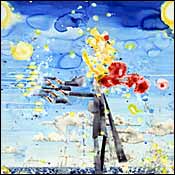
Bloody Good
Barnaby Furnas’s bullet-ridden war paintings are art for our times.
He’s just a few years out of Columbia, yet Brooklyn artist Barnaby Furnas has already scored rapturous notices (in the Times and Artforum) and a second solo show at Marianne Boesky Gallery (his first, last year, sold out). His goal since graduation, he says, has merely been to push his own technique—“to try things that shouldn’t work”#&151;rather than make attractive, gallery-ready works. Which is why he’s more than a bit surprised that his bloody, bullet-ridden battle scenes (based on Civil War mythology, and rendered in watercolor and urethane) have become so prized by collectors. But his followers know an artist hot-wired into the Zeitgeist when they see one. Furnas’s apocalyptic oeuvre not only speaks directly to our times but takes an action painting–meets–The Matrix approach to representation. The inspiration for his work, he says, began with a trip to the Louvre, where he wondered, “If you updated history painting now, what would it have to look like? Like, how intense would it have to be?” Very intense, apparently.—Simon Dumenco • Details: Marianne Boesky Gallery (September 5–October 4).

Camera Ready
“Strangers,” the ICP’s first triennial, challenges the boundaries of documentary photography.
Since moving to its sleek headquarters at Sixth Avenue and 43rd Street, the once-sleepy ICP has been acting more and more like an edgy art museum. And now it seems to have taken the always-controversial Whitney Biennial as its model for “Strangers: The First ICP Triennial of Photography and Video,” an overview of photographers and video artists, from the Dutch portraitist Rineke Dijkstra to American icon Joel Sternfeld. “The title, ‘Strangers,’ gave the show focus,” says ICP chief curator Brian Wallis. “We looked at people who are interested in interpersonal encounters—many of whom are question-ing the premises of documentary photography and photojournalism.” Possibly no one is stretching those genres further than Justine Kurland, whose staged photographs of Americans living (and sometimes posing naked) on communes are at once contemporary and nostalgic.—Edith Newhall. • Details: Strangers, at ICP (September 13–November 30).
Best of The Rest
UN Real Estates Art in General (September 6–December 20). The first national touring solo exhibition of Cuban-born artist Maria Elena González’s undulating cast-rubber and fiber-cement sculptures.
George Inness and the Visionary Landscape National Academy of Design Museum (September 17–December 28). A retrospective of the nineteenth-century American artist’s landscapes.
Pencil: Drawings From the Collection MoMA QNS (September 18–January 12). Drawings from MoMA’s collection by Cézanne, Matisse, Malevich, Picasso, Kelly, Twombly, Oldenburg, and others.
The Dawn of Photography: French Daguerreotypes, 1839–1855 Metropolitan Museum of Art (September 23–January 4). Some 175 of the best surviving examples of the daguerreotype, including works by Alibert, Itier, Gros, Daguerre, Moulin, Clausel, De Molard, and others.
Look ahead: September | October | November | The Comebacks
OCTOBER
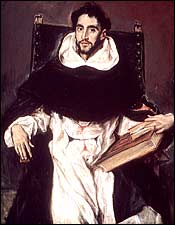
Religious Experience
The Met salutes El Greco, master of mysticism—and intensely soulful portraiture.
One of art’s greatest visionaries, El Greco (1541–1614) infused the human body with spiritual fire. His figures flicker and twist upward; their otherworldly sheen recalls the luminous intensity of the saint. Such an artist might seem foreign to our secular contemporary world, but in fact, El Greco is a discovery of modern taste. For centuries, his religious paintings were considered overwrought. It took eyes accustomed to Picasso and Pollock to appreciate his extravagant originality.
The exhibition coming to the Metropolitan Museum of Art will include about 80 pictures, with an emphasis on the artist’s later, more mystical creations. Even the astonishing nine-foot-tall The Adoration of the Shepherds, which El Greco made for his own tomb, will be coming to New York. But the show also includes a full accounting of the master’s other work. A well-traveled and cultivated man, fluent in the varied ideas of his time, El Greco began as a Byzantine icon painter in Crete and studied Italian art in Venice and Rome before finally settling in Toledo, Spain.
In addition to making religious art, El Greco painted some of the greatest portraits of the era—unsparing and psychologically acute, but not unkind. The subject of the magnificent Fray Hortensio Felix Paravicino, for example, was an ardent admirer of the artist who dedicated four poems to him. El Greco could see the flesh as well as the soul.—M.S. • Details: El Greco, at the Met (October 7–January 11).
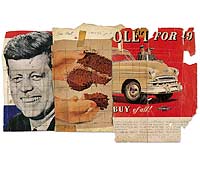
Americana Idol
Pop star James Rosenquist gets his first big retrospective in 30 years.
James Rosenquist twirls the Pop kaleidoscope. He values the passing pow! of a good commercial. He likes candied colors. He understands the way we glimpse pieces of imagery when we flip through a magazine or travel along a strip of gas stations and fast-food joints. Born in North Dakota, Rosenquist actually earned his living in the late fifties by painting billboards—an ideal occupation for a man who would join Andy Warhol, Roy Lichtenstein, and Claes Oldenburg as one of the founders of Pop art.
The retrospective at the Guggenheim Museum is the first significant survey of Rosenquist’s art in more than 30 years. It will include almost 170 works in a variety of media. Rosenquist typically juxtaposes snippets of Pop imagery, usually taken from advertisements, to create enigmatic effects and meanings. In The Promenade of Merce Cunningham, he depicted a pair of shoes with untied laces dancing on a floor of chicken chow mein. That bizarre image was itself superimposed on the fragment of a female face.
In recent years, curators and artists have repeatedly transformed the hallowed space of the Guggenheim, the Matthew Barney extravaganza being the most recent example. It will be interesting to see how Rosenquist’s art looks in Frank Lloyd Wright’s meditative spiral. The artist’s monumental F-111—the embodiment of America’s romance with top guns—should soar there. Remember the motorcycles at the Guggenheim? Well, now we’ll have fighter planes.—Mark Stevens • Details: James Rosenquist: A Retrospective, at the Guggenheim (October 17–January 25).
Best of The Rest
The Jewish Journey: Frédéric Brenner’s Photographic Odyssey Brooklyn Museum of Art (October 3–January 11). More than 140 photographs taken by the contemporary French photographer during his travels to Jewish communities around the world (like Buenos Aires’s Barrio Freud) over the past 25 years.
Russia Engages the World, 1453–1825 The New York Public Library (October 3–January 31). Rare illuminated manuscripts, early printed books, engravings, watercolors, and maps tracing Russia’s interaction with Europe, Asia, and the Americas during its imperial ascendancy.
In Conversation: A Centennial Exhibition of Photographs by Aaron Siskind Whitney Museum of American Art (October 4–February 1). Works from the Whitney’s collection, private collections, and the Aaron Siskind Foundation.
The Drawings of François Boucher The Frick Collection (October 8–December 14). The first major exhibition of the French painter and draftsman (1703–1770) in 25 years.
Isamu Noguchi and Modern Japanese Ceramics Japan Society (October 9–January 11). Traditional and avant-garde ceramics made by the artist—and nine of his Japanese contemporaries—during his trips to Japan.
Trisha Brown: Dance and Art in Dialogue, 1961–2001 New Museum of Contemporary Art (October 10–January 25). Paintings, drawings, sculptures, and sets made by Robert Rauschenberg, Nancy Graves, Donald Judd, and others for Brown’s performances.
Hunt for Paradise: Court Arts of Iran, 1501–1576 Asia Society (October 15–January 18). Paintings, ceramics, carpets, textiles, and metalwork produced in the early reign of the Safavid dynasty.
Treasures From the Collection Cooper-Hewitt, National Design Museum (October 16–May 2). Seventy objects and materials from the museum’s holdings—including a first-century A.D. Roman glass bowl and a seventeenth-century Persian silk velvet panel—selected by Cooper-Hewitt director Paul Warwick Thompson.
Viennese Silver: Modern Design, 1780–1918 Neue Galerie (October 17–February 16). More than 180 extraordinary objects of daily use, many of which were created for the Hapsburg monarchy.
Petra: Lost City of Stone American Museum of Natural History (October 18–July 6). The most comprehensive exhibition ever to explore the ancient metropolis of Petra, in present-day Jordan, and its inhabitants/founders, the Nabataeans.
The Bill Blass Collection Sotheby’s (October 14–21). Over 1,000 items—including Picasso’s 1932 drawing Nu Couché (estimated at $5 million to $7 million)—from the late designer’s New York apartment and Connecticut house.
Look ahead: September | October | November | The Comebacks
NOVEMBER
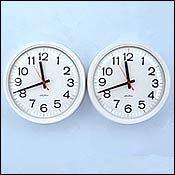
Mona’s MoMA
Mona Hatoum is the latest artist to give curating a try.
Artists love to moan about museums—and especially about curators. But since 1989, when Kirk Varnedoe initiated “Artist’s Choice” exhibitions at MoMA, some—like Ellsworth Kelly and Chuck Close—have had a chance to create shows of their own, selecting works from the museum’s permanent collection.
This fall, it’s Mona Hatoum’s turn. The Lebanese-born, London-based artist, known for her performances, videos, sculptures, and installations, presents “Here Is Elsewhere.”
What do the works you’ve chosen have to do with one another?
Most of these artists, either because of their gender, sexual orientation, color, or cultural background, can be seen as inhabiting an elsewhere. And most of the work is not purely visual, art-for-art’s-sake kind of work.
So it’s overtly political?
It engages with real issues, but without being obvious. For instance, I chose works by Felix Gonzales-Torres because of his interesting use of Minimalism and his appropriation of “high art” strategies. I especially like his “stacks” and “candies” pieces that totally undermine the don’t-touch dictum of museums. You can actually help yourself to a sheet of paper or a candy.
Are you designing the show’s installation? Does it reflect your own work?
Yes, but the only thing related to my own work is that I use a wide variety of media. One room is devoted to a video installation by Jane and Louise Wilson, Stasi City, which was shot in the former East German secret-police headquarters. It’s as if they are trying to show the traces of power embedded in the architecture.
Any artists you’d like to see curate?
Perhaps Mark Dion or Fred Wilson, who’ve made the museum the subject of their work. But any artist had better make sure they have plenty of time. Curating is a lot of work. —E.N. • Details: Here Is Elsewhere, at MoMA QNS (November 7–February 2).
Best of The Rest
Wim Wenders James Cohan Gallery (November 8–December 20). The first New York solo show of photographs by the director known for such films as Wings of Desire and The Buena Vista Social Club.
Unrepentant Ego: The Self-Portraits of Lucas Samaras Whitney Museum of American Art (November 13–February 8). A survey of the artist’s self-portraiture, in drawings, photographs, sculptures, mirrored environments, and films.
John Currin Whitney Museum of American Art (November 20–February 22). Currin’s first solo museum show in the United States comes to New York, featuring approximately 40 of his Cranach-influenced paintings of women, men, and couples.
Look ahead: September | October | November | The Comebacks
The Comeback Adults
This fall, an unprecedented number of solo shows return once-“It” artists to the limelight.
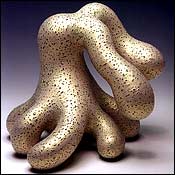
Ken Price
Then: The L.A. artist and Ferus Gallery alum admired for his ceramic sculptures has made appearances at Franklin Parrasch Gallery.
Now: He’s with Chelsea powerhouse Matthew Marks (523 West 24th Street; September 20– November 1).
Judy Pfaff
Then: Her last New York show was in 1997, at the late, great André Emmerich Gallery.
Now: The installation artist and sculptor of fantastical, found-material structures (made of steel tubing, driftwood, fiberglass, and blown glass, among other things), who broke ground for a slew of younger artists (including Jessica Stockholder), has hooked up with a similarly blue-chip 57th Street gallery. Her new site-specific installation, Neither Here Nor There, will be at Ameringer & Yohe (20 West 57th Street) September 4–October 11.
Sally Hazelet Drummond
Then: This 79-year-old abstract painter—who was included in “Americans 1963” at MoMA and had a Corcoran Gallery retrospective in 1972—was known for her minimal, targetlike compositions that were light at the edges and dark in the middle. But her last solo show here was in 1979.
Now: Turns out she’s still painting away, and is showing her latest efforts—which are dark at the edges and light in the middle—in Chelsea. (Mitchell Algus, 511 West 25th Street; October 16–November 16.)
Janine Antoni
Then: The ever-surprising Bahamas-born performance artist and sculptor literally gnawed, licked, and winked her way to prominence in the late nineties.
Now: After four years, she’s back with To Draw a Line, two lead-ingot-loaded, nine-foot steel reels placed on inclined planes and linked by a 24-foot-long expanse of hemp rope, on which the artist will balance herself for as long as she can, eventually (or inevitably) falling onto a cloud of raw hemp fiber below. (Luhring Augustine, 531 West 24th Street; September 6–October 25.)
Adam Fuss
Then: Fuss—known for his eerie photograms of newborn babies and snakes—has had only one show at Cheim & Read since 1997.
Now: His second show will include daguerreotypes of human skulls. (547 West 25th Street; October 16–November 15.)